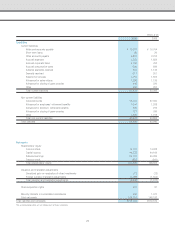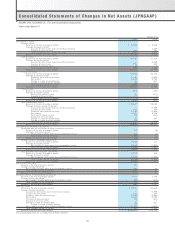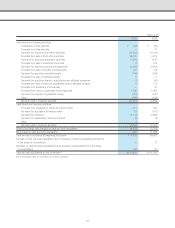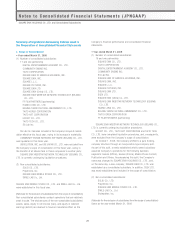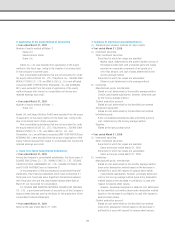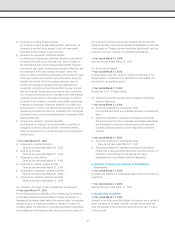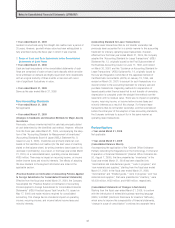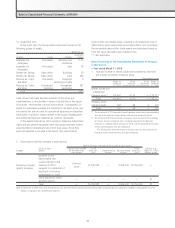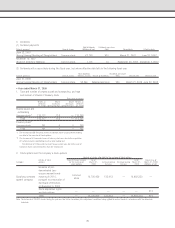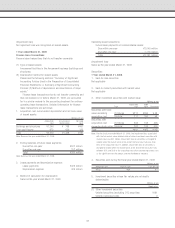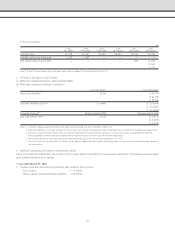Square Enix 2009 Annual Report Download - page 34
Download and view the complete annual report
Please find page 34 of the 2009 Square Enix annual report below. You can navigate through the pages in the report by either clicking on the pages listed below, or by using the keyword search tool below to find specific information within the annual report.
• Year ended March 31, 2009
Goodwill is amortized using the straight-line method over a period of
20 years. However, goodwill whose value has been extinguished is
fully amortized during the fiscal year in which it was incurred.
7. Scope of Cash and Cash Equivalents in the Consolidated
Statements of Cash Flows
• Year ended March 31, 2008
Cash and cash equivalents in the consolidated statements of cash
flows are comprised of cash on hand, bank deposits which are able
to be withdrawn on demand and highly liquid short-term investments
with an original maturity of three months or less and with minor
risk of significant fluctuations in value.
• Year ended March 31, 2009
Same as the year ended March 31, 2008
New Accounting Standards
• Year ended March 31, 2008
Not applicable
• Year ended March 31, 2009
(Changes in Standards and Valuation Methods for Major Assets)
Inventories
Previously, ordinary inventories held for sale had principally stated
at cost determined by the identified cost method. However, effective
from the fiscal year ended March 31, 2009, accompanying the adop-
tion of the “Accounting Standard for Measurement of Inventories”
(Accounting Standards Board of Japan (ASBJ) Statement No. 9,
issued on July 5, 2006), inventories are primarily stated at cost,
based on the identified cost method (for the best value of inventory
stated on the balance sheet, by writing inventory down based on its
decrease in profitability). As a result, in the fiscal year ended March
31, 2009, on a consolidated basis, operating income decreased
¥685 million. There was no impact on recurring income, or income
before income taxes and minority interests. The effects of adopting
the new standard to the segment information are noted in the
applicable section.
(Practical Solution on Unification of Accounting Policies Applied
to Foreign Subsidiaries for Consolidated Financial Statements)
Effective from the fiscal year ended March 31, 2009, the Company
has adopted the “Practical Solution on Unification of Accounting
Policies Applied to Foreign Subsidiaries for Consolidated Financial
Statements” (ASBJ Practical Issues Task Force No.18, issued on
May 17, 2006) and made revisions required for consolidated
accounting. This change had an immaterial impact on operating
income, recurring income, and income before income taxes and
minority interests.
(Accounting Standard for Lease Transactions)
Finance lease transactions that do not transfer ownership had
previously been accounted for in a similar manner to the accounting
treatment for ordinary operating lease transactions. However,
effective from the fiscal year ended March 31, 2009, the Company
adopted the “Accounting Standard for Lease Transactions” (ASBJ
Statement No. 13, originally issued by the First Subcommittee of
the Business Accounting Council on June 17, 1993, and revised
on March 30, 2007) and the “Guidance on Accounting Standard for
Lease Transactions” (ASBJ Guidance No. 16, originally issued by
the Law and Regulation Committee of the Japanese Institute of
Certified Public Accountants (JICPA) on January 18, 1994, and
revised on March 30, 2007) to account for such transactions in a
manner similar to the accounting treatment for ordinary sale and
purchase transactions. Regarding methods for depreciation of
leased assets under finance lease that do not transfer of ownership,
depreciation is computed under the straight-line method over the
lease term with no residual value. There was no impact on operating
income, recurring income, or income before income taxes and
minority interests as a result of this change. For finance lease
transactions that do not transfer ownership, and that commenced
before the initial year of the adoption of new accounting standards,
the Company continues to account for in the same manner as
operating lease transactions.
Reclassifications
• Year ended March 31, 2008
Not applicable
• Year ended March 31, 2009
(Consolidated Balance Sheets)
Accompanying the application of the “Cabinet Office Ordinance
Partially Amending the Regulations on the Terminology, Format and
Preparation of Financial Statements” (Cabinet Office Ordinance No.
50, August 7, 2008), the item presented as “inventories” in the
fiscal year ended March 31, 2008 has been classified into
“merchandise and manufactured goods,” “work in progress,” and
“raw materials and supplies,” starting from the fiscal year ended
March 31, 2009. In the fiscal year ended March 31, 2008,
“merchandise” and “finished goods,” “work in progress,” and “raw
materials and supplies,” that were presented as “inventory,” were
¥2,629 million, ¥639 million, and ¥999 million, respectively.
(Consolidated Statements of Changes in Net Assets)
Starting from the fiscal year ended March 31, 2009, to conform
with the introduction of extensible business reporting language
(XBRL) to EDINET (Electronic Disclosure for Investors’ NETwork),
which aims to improve the comparability of financial statements,
“change in scope of consolidation” combines two separate items
Notes to Consolidated Financial Statements (JPNGAAP)
32



